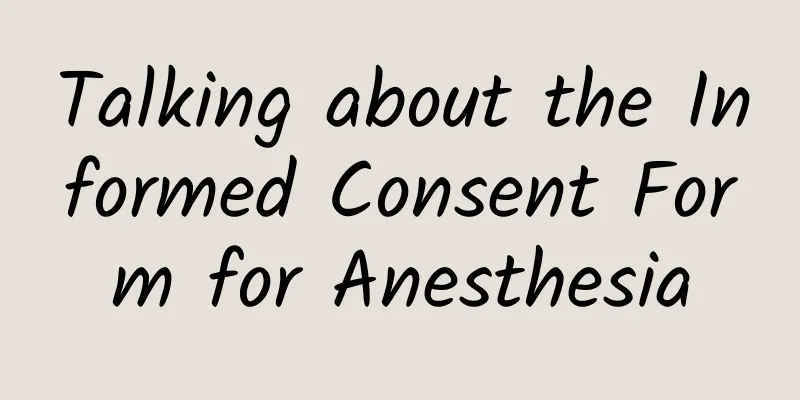Talking about the Informed Consent Form for Anesthesia

|
For the first time, I realized that the anesthesia informed consent form is not just a thin piece of paper! When I share with a new anesthesia colleague how to enter the world of anesthesia faster, I wonder, what can I teach her? Skill operation? This requires more practice and practice. Just talking about my personal experience alone has no practical significance to her. Theoretical knowledge? There is too much knowledge related to anesthesia. What can I pass on to her in just one operation? After the anesthesia induction was completed, everything was on track. While cleaning the table, I was thinking about how to make her gain something from the anesthesia during this operation. The anesthesia informed consent form came into view! Got it! Let's start with the anesthesia informed consent form! Let's start with some nitpicking! Anesthesia informed consent, as the name suggests, is a document regarding anesthesia that requires the consent of the patient and (or) the patient's family. So why do we need such a document? Because anesthesia has risks! Some unexpected situations may occur during the anesthesia process, which may cause certain harm or even life-threatening to the patient, so we have to inform him/her. This is also a manifestation of practicing in accordance with the law, reflecting the patient's right to be informed and make independent choices, and also reflects the anesthesiologist's obligation to inform! Very important, right! ? Yes, it is very important. When I said this, I couldn't help but nod my head. So when we visit patients with such a thin piece of paper, we must be serious and cautious, bold and enthusiastic! Do you think that knocking on the door of the ward is our first contact with the patient? No, from the moment we get the informed consent for anesthesia, we have had the first non-face-to-face contact with the patient. The patient's name, age, gender, and hospitalization number are basic information. What does it indicate? Name and hospitalization number are important and unimportant; they are important because we have to "check three times and check seven times" to ensure that we don't recognize the wrong person or understand the wrong condition information. They are unimportant because they have little to do with the choice of anesthesia method and anesthesia precautions. Relative to anesthesia, age and gender are more important. Why? Because age is an independent high-risk factor. For the same operation, the anesthesia risks of infants, young and middle-aged people, and the elderly are different, the choice of anesthesia plan will also change, and the points to pay attention to during anesthesia implementation are also different; gender! It is mainly related to the higher incidence of perioperative nausea and vomiting. After reading these, you should understand the patient's medical information and related test results. If you don't know what to focus on when reviewing the medical records, then continue to read the informed consent form. Article 1: Risks associated with primary diseases. Okay, then take a good look at the medical records to see what diseases the patient has, what pathological and physiological changes may occur in these diseases, and what impact may these pathological and physiological changes have on our anesthesia? This is what we need to focus on in the medical records. After reading the medical records and confirming that the surgery is to be performed, you can roughly determine which anesthesia plan to choose. Then, when you don't know what to do, continue to read the anesthesia informed consent form. Possible problems encountered with general anesthesia, possible accidents with spinal anesthesia, possible situations with nerve blocks, possible consequences of intraoperative blood transfusions, surgery-related accidents... At this point, I stopped. Is this really a thin piece of paper? ! For the first time, I deeply realized that the anesthesia informed consent form is not just a thin piece of paper. It is a book, many books, blood and tears, history, and the accumulated anesthesia science! If you are just getting started, read it carefully and you will know how to make a good anesthesia plan, how to prepare for an anesthesia surgery, and what problems you need to deal with during the operation; if you have been in the industry for many years, read it again, and you will find that the words are full of fear and trepidation, but you must be bold and careful, and stay calm! [Warm Tips] Follow us, there are a lot of professional medical knowledge here, revealing the secrets of surgical anesthesia for you~ |
<<: Do you need a bone density test?
Recommend
Distribution map of women's important organs
The liver, spleen and kidneys are the three most ...
Luotu Technology: China's smart tablet shipments reached 7.131 million units in Q3 2024, up 3.5% year-on-year
According to the latest news released by Luotu Te...
The fastest way to pass gas during cesarean section
The best way for pregnant women to give birth is ...
There's only one drug left to fight this "human killer," and now it's starting to fail
Salmonella enterica serovar Typhi (S. typhi) Imag...
There is no "magic weight loss drug" in the world
Recently, there was big news coming from China’s ...
Pelvic floor exercises
Normally we are always moving our bodies, but don...
Metronidazole vaginal suppository
Gynecological inflammation makes many women endur...
Pain and itching in the genitals at night should be taken seriously
Because the female genitals are in direct contact...
Why is the girl wet down there?
As we all know, after women have sex with their l...
Breast changes during one month of pregnancy
Why do I have breast pain one month into my pregn...
Is ketogenic diet really effective for weight loss?
As the saying goes, if you don’t lose weight in M...
What is a four-leaf clover? What is the growing environment of a four-leaf clover?
I believe everyone is familiar with the four-leaf...
Introduction to scraping method for breast hyperplasia
I believe that everyone is not unfamiliar with br...
How much does cervical conization cost?
Cervical diseases have always been one of the key...
Can scanty menstruation be cured?
The amount of menstruation for female friends is ...









